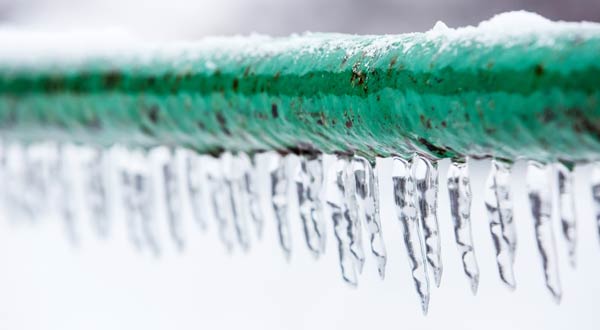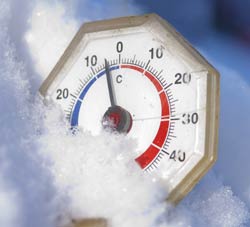
Keep Your Facilities Safe and Warm This Winter
The holidays are full of surprises like home baked treats, gifts, cold weather — and frozen pipes. An even bigger surprise is that it’s not just pipes in older buildings that freeze; those in new/renovated buildings freeze just as easily. In fact, over the past few years, more and more PDRMA members have experienced exactly that situation.
Even when construction or renovation plans look good on paper, it doesn’t mean a harsh cold snap won’t have unexpected results. Dan Fritz, Senior Consultant at Kodiak Fire Protection Services, Inc., recommends keeping up with cold-weather maintenance regardless of the age of your buildings.
“That vestibule heater might be the right size for the square footage, but it may not be able to keep the area warm enough to protect pipes when temps are near zero and people keep opening those exterior doors,” Fritz notes. “Vestibules, outside walls or dead spaces with no heat are tricky, and newer buildings are especially vulnerable to sprinkler system freeze ups. A deficiency may not show up until the first extended stretch of sub-freezing weather — and that could be years later.”
That makes it critical to be vigilant before temperatures drop.
- Inspect the building envelope to ensure it is in good condition, and close unnecessary openings.
- Perform a walk-through regularly to identify any areas subject to low temperatures.
- Install thermometers — ones you can check remotely — in potential problem areas to monitor temperature.
- Improve insulation and heat in areas with the potential to freeze.
- Confirm low building-temperature alarms work.
Fritz also suggests staying up to date on maintenance of sensitive equipment. “Inspect private fire hydrants and have a contractor service them to ensure the barrel is draining properly,” he explains. “Hydrants that don’t properly drain could freeze during a sustained period of sub-freezing temperature resulting in hydrant or underground pipe ruptures.”
Dry Pipe and Antifreeze Systems
Fritz adds that if you have buildings equipped with dry-pipe or antifreeze systems, you should service them prior to the onset of cold weather as well. “Include it as part of the contractor’s annual system inspections, and schedule them for the fall,” he advises.
- Service low-point drains of dry-pipe automatic sprinkler systems to prevent freezing.
- Verify the dry-pipe sprinkler riser enclosure has adequate heat and insulation to maintain temperatures above 40°F.
- Test or replace antifreeze systems’ solution.
- Annual contractor system-inspections should include all servicing and occur in the fall before the onset of cold weather.
When Bad Weather and Bad Luck Coincide
 When Becky Cooper was Safety Manager at Carol Stream Park District, she experienced the effect an extended cold snap can have on pipes. And she brought those lessons learned to her current position as Safety Manager at Naperville Park District. Her experience began in a vestibule at Carol Stream Park District’s Fountain View facility… When Becky Cooper was Safety Manager at Carol Stream Park District, she experienced the effect an extended cold snap can have on pipes. And she brought those lessons learned to her current position as Safety Manager at Naperville Park District. Her experience began in a vestibule at Carol Stream Park District’s Fountain View facility…
“It was basically bad luck,” Cooper explains. “The temperature had dropped drastically early in the season; it was so cold outside the sprinkler head in one of the vestibules at our new recreation center froze and ruptured. That caused the sprinkler system to release the water stored in it. The vestibule’s location meant that hallway was not being used regularly, and we hadn’t realized how cold it was until the fire alarm went off and water poured through the doors into the main hallway — seeping into the gymnasium and onto our practically brand-new wood floors.”
This incident was the third time a sprinkler system or pipe broke at a Carol Stream facility — and all within a few weeks — so Cooper took action. “We evaluated all vestibules and standalone buildings we had closed for the season to ensure they were properly insulated and had sufficient heat sources to keep the areas above freezing. We made sure if the exterior temperature dropped below a certain point, other heat sources inside would kick on to keep those at-risk areas warm.”
Now at Naperville Park District, she routinely works with the trades department in three park divisions to evaluate and winterize all facilities. She also ensures the planning department works closely with the trades and parks departments to determine if and when a building needs capital improvements to protect against freezing.
Cooper advises fellow PDRMA members to prepare, plan and take action to prevent pipes from rupturing. “Evaluate all facilities for proper insulation before it gets too cold out,” she says, “and make sure your agency has a good winterization plan in place with an established timeline to get buildings ready for cold weather.”
She also recommends having the facility manager or someone from the trades department check all vestibule areas to ensure they have proper insulation. “If they don’t, it’s worth the time and money to add insulation or a heat source to keep pipes and sprinkler heads from freezing.” It’s definitely a case of better safe — and warm — than sorry.
PDRMA Resources:
|

